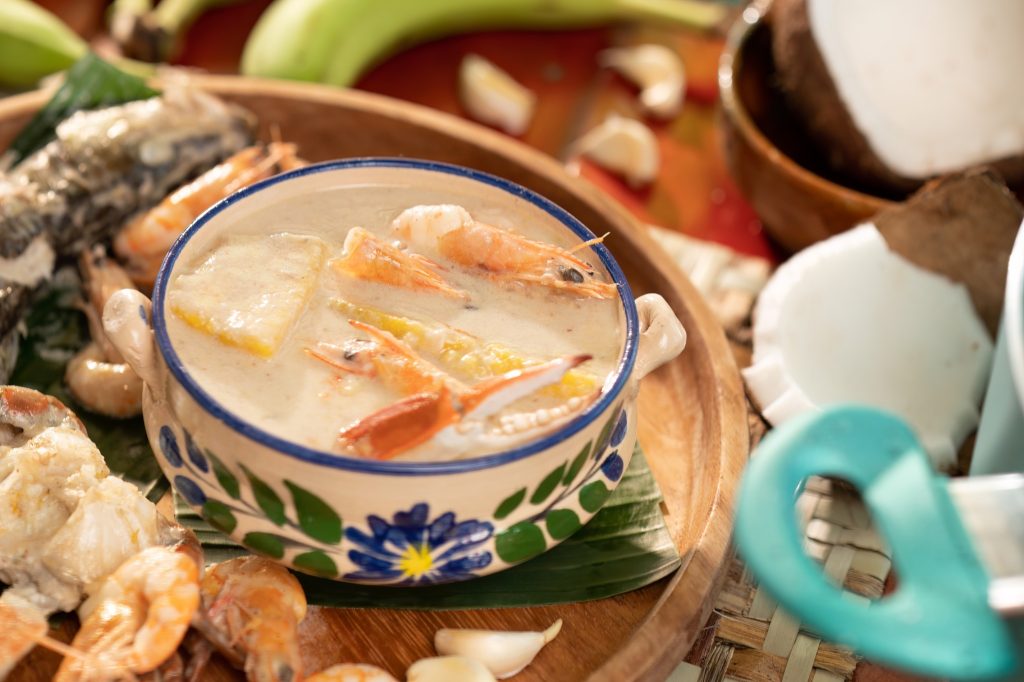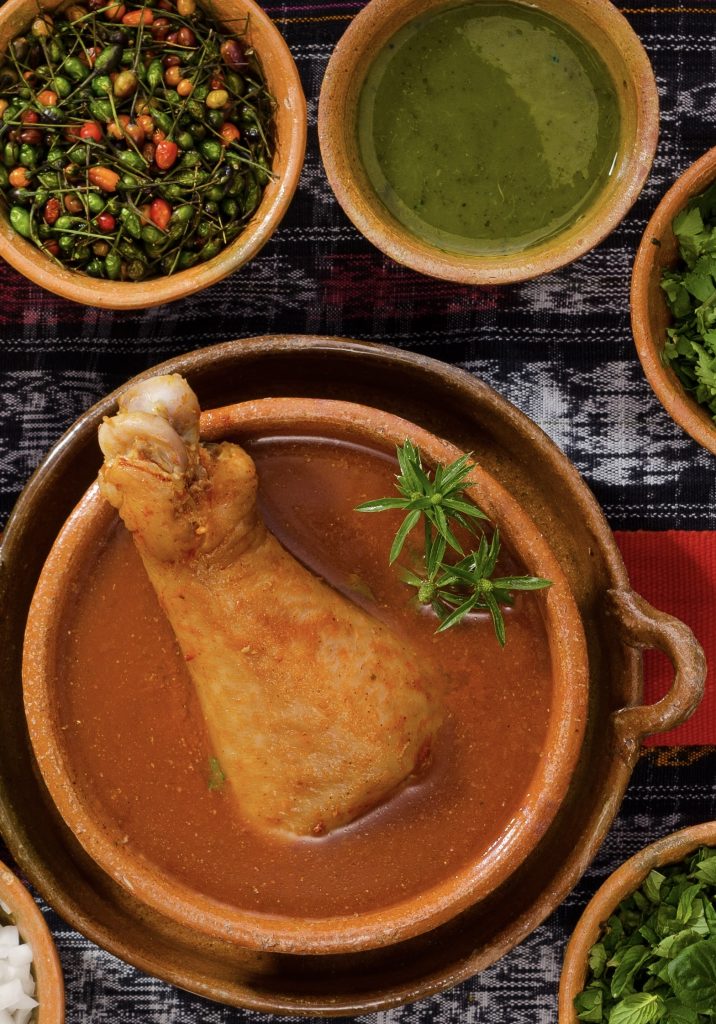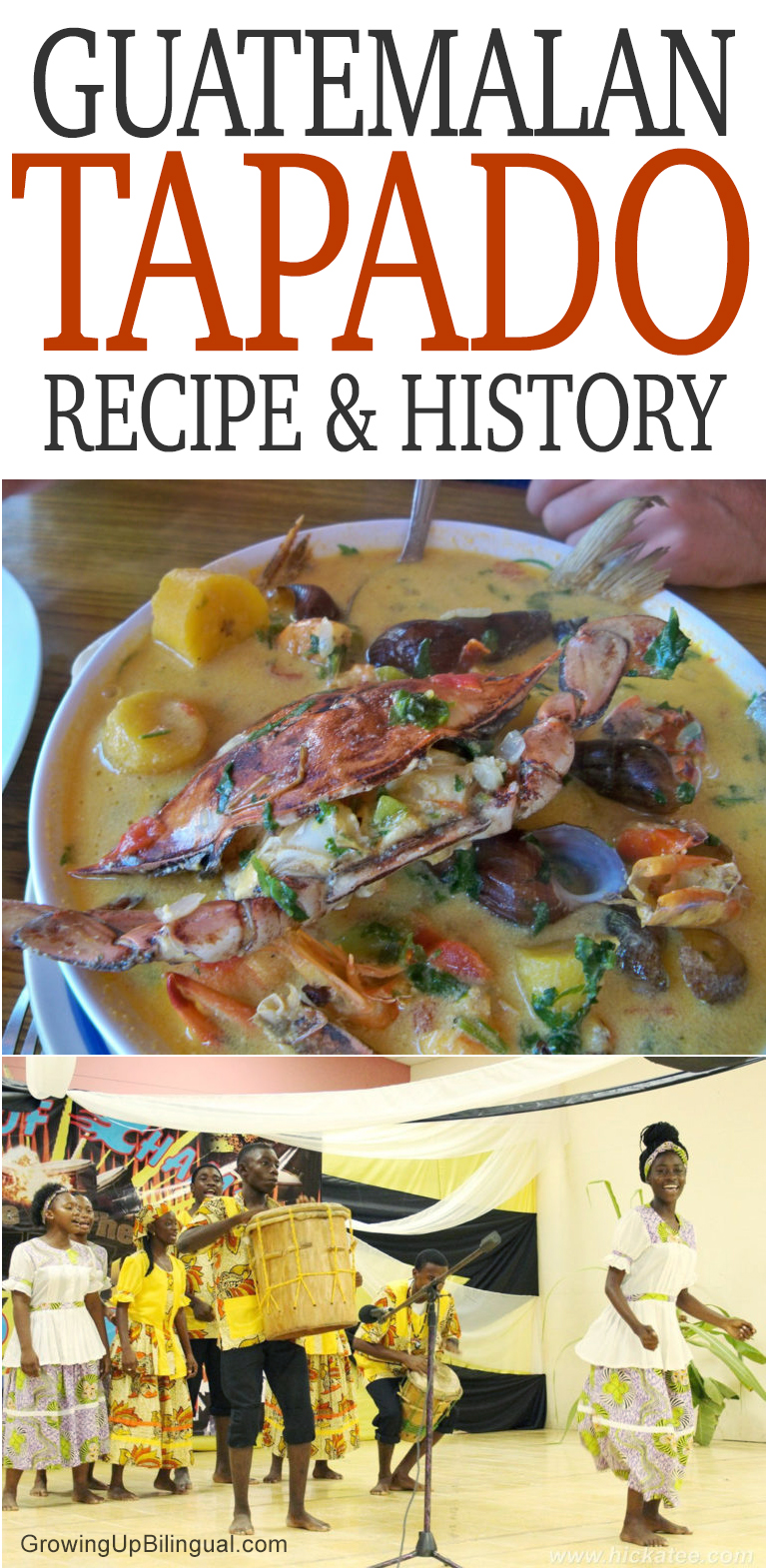This post is also available in: Español
This recipe for Guatemalan tapado is sure to become one of your favorite comfort foods. Guatemala’s Tapado seafood soup is a legacy of history and an explosion of flavor. This Guatemalan traditional dish is filled with Caribbean and Garifuna flavor combining seafood and tropical flavors like coconut and plantain.

Food is a wonderful thing, it not only fills one of your basic biological needs, but it also has the unusual ability to transport you to far away places, intoxicated by its flavors and aromas. When traveling eating the local food is part of taking the history and the character of a place in and understanding a bit more of the culture while sharing a nice time with the locals.
What is Tapado?
One of the unique dishes that Guatemala has to offer is the exuberant and delicious Tapado. If you’re familiar with Guatemala’s cuisine, you would know that Guatemalans are big on stews and retain some of their Mayan heritage by utilizing maize and beans in their concoctions. Tapado, on the other hand, is an entirely different story.
Guatemalan Tapado is a distinctive and flavorful seafood stew, originating from the country’s Caribbean coast, particularly in the region of Livingston. This hearty dish is a melting pot of diverse culinary influences, showcasing the Afro-Caribbean and Garifuna heritage prominent in the area. Tapado brims with an array of fresh seafood like fish, shrimp, crab, and sometimes squid, all simmered in a rich, coconut milk-based broth infused with aromatic herbs and spices. The stew often includes plantains and yucca, adding a unique texture and sweetness that balances the savory flavors. Served with rice, Tapado is not just a meal but a celebration of Guatemala’s diverse cultural landscape, embodying the coastal region’s vibrant and eclectic spirit.
What is the history behind the Guatemalan tapado recipe?
Following the Atlantic coast of Central America, the Garifuna people (or, more accurately Garinagu) live in Honduras, Nicaragua, Belize, and Guatemala, mainly in the coastal city of Livingstone. The story on its own is an exhilarating adventure. Originally from southern Nigeria, they were shipped as slaves by the British, but as a storm hit their vessel, they skillfully survived the shipwreck and were stranded on the Caribbean island of St. Vincent. There, they were welcomed by the Caribs, a group of people who had Arawak ancestry from mainland South America, around the Orinoco River. As part of their integration, they intermarried with the Caribs and created a new ethnic group. As St. Vicent was later taken by the British, the Garifuna were displaced to the island of Roatán, near the coast of Honduras. Then they later made a pact with the Spanish and moved on to the mainland where they still reside. Talk about an adventure.

Nowadays, the Garifuna live a more sedentary life, but not a quiet one. They still aspire to keep their traditions in a modern and changing world, as their music and dances retain their African influence and on special occasions, create a cacophony of drums, songs, and Punta dance, topped by delicious food.
Equally, their dishes maintain a millenary heritage that was born out of the collision and blend of various cultures. Eating a Garifuna plate is eating a bit of their history and culture. They are masters at processing cassava into ereba (cassava bread), or manioc, which, for the undertrained enthusiast, can prove to be poisoned. They incorporate rich flavors like coconut milk, plantains, coriander, and seafood.

Taking a trip to Izabal and walking through Livingstone, greeted by the friendly Garifuna kids and cheeky grandmas, the experience is only complete with a big bowl of tapado. So what is tapado? It’s the brilliant and harmonious mixture of luscious seafood cooked in savory coconut broth. How can this work? It simply does, and it is mouth-watering delicious.
Cooking it is an experience of its own and leaves a lot of room for experimentation, which makes it fun to share with friends or family on a sunny day. Some ingredients, like the amount of seafood, can vary depending on your preferences, but most of them you can find anywhere.
What are the ingredients for the Guatemalan tapado recipe?
Here are the main ingredients that you would find in the tapado.
Seafood: when it comes to Tapado you can play around with your favorite seafood. You can either just use fish or go crazy and make a seafood mixture and include everything from clams, oysters and shrimp to crab and lobster. Up to you!
Plantains: plantains are one of the ingredients that make Tapado seafood stew or soup really stand out. It gives it a delicious and unique flavor!
Coconut milk: because Tapado is a dish that has its roots in the Garifuna culture, where many of the dishes incorporate tropical ingredients like coconut, it just makes sense that tapado includes coconut milk.
Vegetables: tapado usually includes tomatoes, onions, sweet pepper and potatoes, but you can omit the potatoes. It’s all about making this recipe yours and adding or leaving out ingredients that make sense to you. Everyone who makes it in Guatemala has their own family recipe and makes slight changes to it.

Guatemalan Tapado Recipe
Guatemalan Tapado Recipe Ingredients (3-4 servings)
- 2 cups of coconut milk
- 2-3 green plantains – peeled and sliced
- 1 white onion – thinly diced
- 2-3 large plum tomatoes – diced
- 1 potato (optional) – cut into thin slices
- 1 bell pepper (optional) – cut into strips
- 1 tbsp. of vegetable/olive oil
- 1 tbsp. of fresh oregano – chopped
- 1 tbsp. of fresh coriander to garnish – chopped
- ½ tbsp. of chicken bouillon
- 1-2 cloves garlic – minced
- 1 tsp. of ground achiote (annato)
- 1 lemon
- salt and pepper to taste
- 2 lbs. of snapper fillet
- 1 lb. clams
- 1 lb. oysters
- 1 lb. shrimp
- 3 crabs (in Guatemala you would use blue crabs)

Guatemalan Tapado Recipe Instructions
- Take the pot with olive/vegetable oil and sauté for a few minutes the minced garlic, sliced onion, tomatoes until they are tender. You can also add the potatoes or bell peppers.
- Add the coconut milk and the sliced plantains. Bring to a boil until it takes on an orange color and thicker consistency.
- Add oregano, salt, pepper, achiote and the chicken bouillon at your taste. Play with the flavors.
- Let it cook for 20 or more minutes until the plantains are cooked.
- Clean the fish into a fillet and salt it. Place it into the pan and simmer in olive/vegetable oil for a couple of minutes on each side.
- Put the fish and the optional seafood in the coconut broth and cook for a couple of minutes.
- Take it away from the heat and serve in a soup bowl. Place coriander leaves to garnish and lemon if needed.
- We suggest you serve it with coconut rice.
Now enjoy and be transported to the warm and mellow Caribbean, under the sun and palm trees, among the charming and lively Garifunas.
Tapado Recipe Variations
Guatemalan Tapado, a beloved seafood stew, exhibits intriguing regional and family variations that reflect the diverse culinary landscape of Guatemala. In the coastal regions, especially around Livingston, where Tapado traces its roots, the stew is richly laden with an abundance of local seafood such as fish, shrimp, crab, and sometimes even squid or lobster. The coastal rendition often features coconut milk, giving it a creamy, tropical flavor that complements the seafood medley.

Inland variations of the dish, however, might substitute some seafood with river fish or incorporate more readily available ingredients. Family recipes passed down through generations introduce their unique twists, with some households favoring a spicier broth infused with local chiles, while others might opt for a sweeter touch with the addition of ripe plantains. These individual interpretations of Tapado not only showcase the adaptability of the recipe to available ingredients but also highlight the rich tapestry of culinary traditions that exist within Guatemala, making each iteration of Tapado a delightful and unique culinary experience.
How to Make the Best Guatemalan Tapado Seafood Stew
- Selecting Seafood:
- Opt for fresh, local seafood. If near the coast, choose fresh catches of the day.
- For shrimp and crabs, look for bright, clear eyes and a fresh ocean scent.
- If using fish, select firm, shiny fish with a mild smell.
- Enhancing Flavors and Textures:
- Marinate seafood in lime juice and spices for a brief period before cooking to enhance flavor.
- Use homemade fish or vegetable stock instead of water for a richer broth.
- Incorporate coconut milk for a creamy texture and tropical flavor.
- Add a variety of spices like cumin, bay leaves, and cilantro to enrich the stew’s aroma.
- Combining Ingredients:
- Sauté onions, garlic, and bell peppers before adding liquids to build a flavor base.
- Layer flavors by adding ingredients in stages, not all at once.
- Balancing Seafood Cooking Times:
- Add seafood in order of cooking time – start with those that take longest to cook.
- Avoid overcooking shrimp and delicate fish to prevent them from becoming rubbery.
- Experiment with Ingredients:
- Try different combinations of seafood based on availability and preference.
- Incorporate green plantains or yuca for an authentic touch and added texture.
- Serving Suggestions:
- Serve tapado hot, ideally with rice on the side to soak up the flavors.
- Garnish with fresh cilantro and a squeeze of lime for added zest.
Other Guatemalan Soup and Stew Recipes
Kak’ik, Guatemalan Turkey Soup
This Guatemalan soup bursts with flavor, featuring juicy turkey, spices, and vegetables. Turkey is the star ingredient in this traditional dish, but the broth gives it its unforgettable taste. The broth is made by blending dried chili peppers, tomatoes, tomatillos, garlic, cilantro, and mint to create a rich, fragrant sauce that balances the tender turkey perfectly.

Pollo En Jocón
This easy chicken stew is one of the most traditional Guatemalan dishes. Delicious and easy to make, it’s the perfect cold-weather comfort food. It consists of chicken simmered in a sauce made with tomatillos and cilantro. Then, you thicken it with toasted sesame seeds, pumpkin seeds, and tortillas.
Cocido De Res
El Cocido de Res is the ultimate Guatemalan comfort food. It is a simple beef stew with corn on the cob, carrots, potatoes, pear squash, and acorn squash. You serve this delicious Caldo over white rice, garnished with avocado and fresh cilantro. And with freshly made tortillas, this beef and vegetable stew tastes like home!

Pepián De Pollo
Pepián de pollo, or chicken pepián, is one of the oldest Guatemalan recipes. This chicken stew is rich in flavors and roasted spices. You can make it with chicken, beef, or pork (or a combination of all). You stew the meat in a tomato-based sauce with roasted seeds and peppers. Adding potatoes and carrots, with white rice as a side dish, makes this recipe a complete meal.


Guatemalan Tapado Recipe
Ingredients
- 2 cups of coconut milk
- 2 green plantains - peeled and sliced
- 1 white onion - thinly diced
- 3 large plum tomatoes - diced
- 1 potato (optional) – cut into thin slices
- 1 bell pepper (optional) – cut into strips
- 1 tbsp. of vegetable/olive oil
- 1 tbsp. of fresh oregano – chopped
- 1 tbsp. of fresh coriander to garnish – chopped
- ½ tbsp. of chicken bouillon
- 1 cloves garlic – minced
- 1 tsp. of ground achiote (annato)
- 1 lemon
- 1 teaspoon salt
- 1/2 teaspoon pepper
- 2 lbs. of snapper fillet
- 1 lb. clams
- 1 lb. oysters
- 1 lb. shrimp
- 3 crabs
Instructions
- Take the pot with olive/vegetable oil and sauté for a few minutes the minced garlic, sliced onion, tomatoes until they are tender. You can also add the potatoes or bell peppers.
- Add the coconut milk and the sliced plantains. Bring to a boil until it takes on an orange color and thicker consistency.
- Add oregano, salt, pepper, achiote and the chicken bouillon at your taste. Play with the flavors.
- Let it cook for 20 or more minutes until the plantains are cooked.
- Clean the fish into a fillet and salt it. Place it into the pan and simmer in olive/vegetable oil for a couple of minutes on each side.
- Put the fish and the optional seafood in the coconut broth and cook for a couple of minutes.
- Take it away from the heat and serve in a soup bowl. Place coriander leaves to garnish and lemon if needed.
- We suggest you serve it with coconut rice.
Nutrition Information:
Yield: 12 Serving Size: 1Amount Per Serving: Calories: 466Total Fat: 15gSaturated Fat: 9gTrans Fat: 0gUnsaturated Fat: 4gCholesterol: 214mgSodium: 1304mgCarbohydrates: 27gFiber: 2gSugar: 8gProtein: 55g
- Why You Should Visit Malaysia: Top Reasons to Explore This Underrated Southeast Asian Destination - April 18, 2017
- Guatemalan Tapado Recipe - April 6, 2017
- An Enchanting River Ride: A Quick Guide To Río Dulce in Guatemala - April 6, 2017


